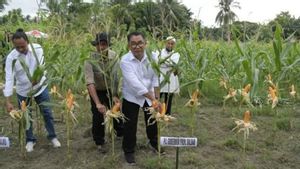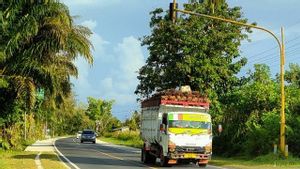JAKARTA - The Ministry of Agriculture through the Directorate General of Horticulture encourages the use of shallot seeds with TSS (True Shallot Seed) technology, also known as the use of botanical seeds, to increase crop yields.
“Indeed, we are still pushing for the development of TSS seeds. We see that production costs, especially the cost of seeds, are cheaper than using bulbs," said Director General of Horticulture at the Ministry of Agriculture Prihasto Setyanto in a statement in Jakarta, quoted from Antara, Wednesday, September 28.
Prihasto said the advantage of TSS shallot seeds is that they are able to increase the yield of shallot bulbs up to two times compared to the use of bulb seeds. In addition, the seeds are also disease and virus free, use less seeds, easier transportation, and longer shelf life than tubers.
About 50 percent of onion seeds from seed can still germinate after 1-2 years of storage. The shelf life of onion seeds from tubers is also only four months.
Despite the many advantages, continued Prihasto, the adoption of TSS seeds by farmers is quite difficult, especially changing old habits into new ones.
"What's the challenge? One, the average seed produces a single tuber. The average community wants tubers with lots of cloves. When asked to the public, they are reluctant to use big ones because they are wasteful,” said Prihasto.
The second challenge, said the man who is usually called Anton, is that the majority of farmers prefer onion varieties that have been used for a long time, such as Bima Brebes and Tajuk.
Furthermore, the third challenge is that the period from planting to harvesting is longer than the existing varieties.
“But for this shallot, the seeds are still very, very limited. Of the existing varieties, there is not yet one for seed development," he said.
The development of a national scale TSS has been initiated by the Directorate General of Horticulture since 2018. In 2020, the Directorate General of Horticulture will develop TSS shallot cultivation in an area of 1,100 hectares, an increase of 915 hectares in 2021. “The 2022 target is 1,000 hectares. TSS technology has the potential to increase production and production cost efficiency,” he said.
In addition to introducing new seeds, the Directorate General of Horticulture is also preparing a national shallot security strategy.
First, providing a large-capacity warehouse equipped with refrigerated storage for stock management. Second, optimizing the use of warehouses in the regions.
SEE ALSO:
Third, said Prihasto, strengthening the inter-regional and inter-time cropping pattern management system. Fourth, improvement of the shallot cultivation system, both tuber and seed origin (TSS). Fifth, activation of onion farming insurance or AUBM.
"We have been pushing since 2018 for this insurance," he said.
Sixth, developing an auction market in shallot production centers. And lastly, coordination and synergy in controlling inflation with champions, Bank Indonesia, and the central inflation monitoring team/regional inflation monitoring team.
The Ministry of Agriculture encourages shallots through horticultural village programs such as shallot villages.
"These villages are concentrated for the development of shallots in one village, an area that has not developed much shallots in the region," said Prihasto.
In the production prognosis and shallot balance for the January-December 2022 period, the Ministry of Agriculture estimates that there will be a surplus at the end of the year. A similar surplus occurred in the last three years, namely 161,851 tons in 2019, 299,228 tons in 2020, and a surplus of 303,910 tons in 2021.
The English, Chinese, Japanese, Arabic, and French versions are automatically generated by the AI. So there may still be inaccuracies in translating, please always see Indonesian as our main language. (system supported by DigitalSiber.id)


















